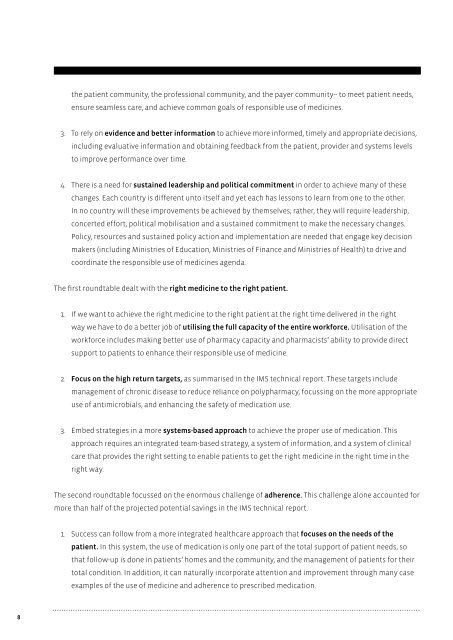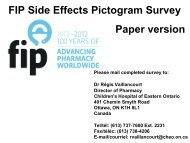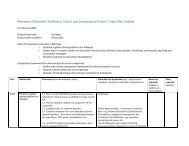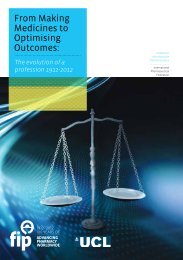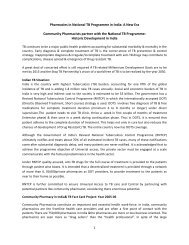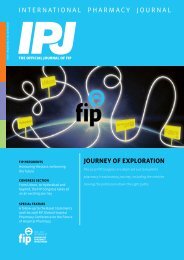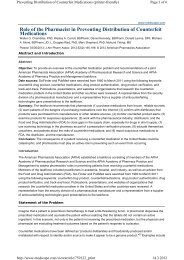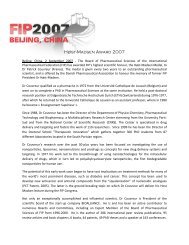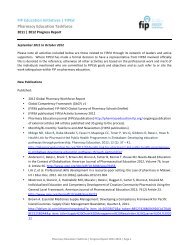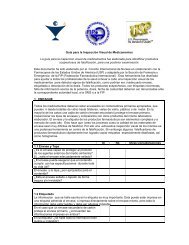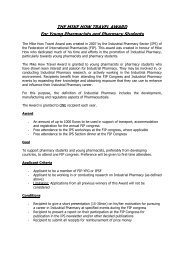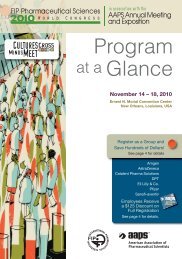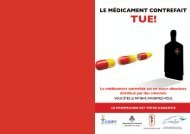here - FIP
here - FIP
here - FIP
Create successful ePaper yourself
Turn your PDF publications into a flip-book with our unique Google optimized e-Paper software.
8<br />
the patient community, the professional community, and the payer community-- to meet patient needs,<br />
ensure seamless care, and achieve common goals of responsible use of medicines.<br />
3. To rely on evidence and better information to achieve more informed, timely and appropriate decisions,<br />
including evaluative information and obtaining feedback from the patient, provider and systems levels<br />
to improve performance over time.<br />
4. T<strong>here</strong> is a need for sustained leadership and political commitment in order to achieve many of these<br />
changes. Each country is different unto itself and yet each has lessons to learn from one to the other.<br />
In no country will these improvements be achieved by themselves; rather, they will require leadership,<br />
concerted effort, political mobilisation and a sustained commitment to make the necessary changes.<br />
Policy, resources and sustained policy action and implementation are needed that engage key decision<br />
makers (including Ministries of Education, Ministries of Finance and Ministries of Health) to drive and<br />
coordinate the responsible use of medicines agenda.<br />
The first roundtable dealt with the right medicine to the right patient.<br />
1. If we want to achieve the right medicine to the right patient at the right time delivered in the right<br />
way we have to do a better job of utilising the full capacity of the entire workforce. Utilisation of the<br />
workforce includes making better use of pharmacy capacity and pharmacists’ ability to provide direct<br />
support to patients to enhance their responsible use of medicine.<br />
2. Focus on the high return targets, as summarised in the IMS technical report. These targets include<br />
management of chronic disease to reduce reliance on polypharmacy, focussing on the more appropriate<br />
use of antimicrobials, and enhancing the safety of medication use.<br />
3. Embed strategies in a more systems-based approach to achieve the proper use of medication. This<br />
approach requires an integrated team-based strategy, a system of information, and a system of clinical<br />
care that provides the right setting to enable patients to get the right medicine in the right time in the<br />
right way.<br />
The second roundtable focussed on the enormous challenge of ad<strong>here</strong>nce. This challenge alone accounted for<br />
more than half of the projected potential savings in the IMS technical report.<br />
1. Success can follow from a more integrated healthcare approach that focuses on the needs of the<br />
patient. In this system, the use of medication is only one part of the total support of patient needs, so<br />
that follow-up is done in patients’ homes and the community, and the management of patients for their<br />
total condition. In addition, it can naturally incorporate attention and improvement through many case<br />
examples of the use of medicine and ad<strong>here</strong>nce to prescribed medication.


